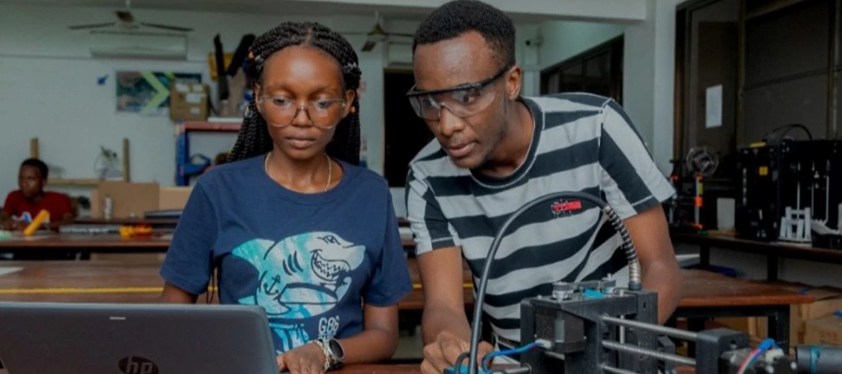Tanzanian girls possess enormous potential to drive economic and social transformation through their participation in science, technology, engineering, and mathematics (STEM). However, pursuing STEM has been an unfulfilled aspiration for many.
According to the 2023-24 Tanzania higher education enrollment data, only 22 and 29 percent of female students enrolled in engineering or information and communication technology, respectively. Every girl left out of STEM education—and eventually STEM jobs in Tanzania—adds up to a national and global STEM skills shortage with notable economic implications.
The World Economic Forum estimates a shortage of over 85 million skilled professionals, especially in the fields of technology and engineering. According to the Engineers for Africa report, there is only one registered engineer for every 8,000 people in Tanzania compared to the global average of over 50 engineers per 10,000 people.
This STEM skills shortage will hinder innovation and potentially lead to a loss of up to $8.5 trillion in global gross domestic product (GDP) by 2030 if not averted. Closing the gender gap in the digital economy could unlock an additional $700 billion in GDP growth, underscoring the need to increase investments to bridge STEM gender disparities.
Investing in secondary STEM education for girls
Investing in STEM will help Tanzania achieve national development goals as outlined in the recently launched Tanzania Development Vision 2025. Prior to implementing fee-free basic education in 2015-16, a gender gap in science and mathematics performance persisted at the secondary level. As a result, the World Bank and the government of Tanzania developed an integrated approach to teacher training, mentorship, and supportive learning environments that enable girls and women to access STEM education.
To bridge STEM gender disparities, the Secondary Education Quality Improvement Project (SEQUIP) has helped strengthen interest in STEM with enhanced STEM facilities and resources, and it has invested in textbooks and infrastructure to improve STEM education. The project has helped construct 830 new schools and over 9,000 classrooms, with multi-purpose science laboratories. Among these are 26 new girls’ secondary schools that focus on mathematics and science. Over 11 million science and mathematics textbooks have been printed and distributed, with a quarter of schools achieving a 1:1 student-textbook ratio.
In addition, SEQUIP has established a pipeline of female STEM leaders in the classroom. With women making up only 33 percent of secondary school teachers, and even fewer being science and mathematics teachers, SEQUIP supports equitable deployment of teachers and strengthens teachers’ content and pedagogical knowledge. Through SEQUIP over 95 percent of all science and math teachers have received in-service teacher training and development; 20 percent of secondary schools have received digital technologies and digital skills training; and 59 percent of secondary schools received training to implement the safe school program.
These interventions have increased the number of female science and mathematics teachers who also serve as mentors and role models to the girls they teach. Ms. Rehema Mwakalinge, a secondary school science teacher, said: “After receiving this training, we can support students to be competent by using locally available materials, making it easier for the students to understand science and mathematics subjects.”
Furthermore, SEQUIP has enhanced transparency to ensure equitable STEM educational opportunities.The digitized school quality assurance system and scorecard reports key educational outcomes of schools, including gender-disaggregated exam results in critical subjects such as science and mathematics. The scorecard’s improved data and transparency are crucial for sustaining community and parental engagement, while highlighting areas that require additional investment.
Reaping investments: STEM skills for STEM jobs
As stated by Prof. Adolf Mkenda, the Tanzania’s Minister of Education, Science and Technology: “The reforms in the education system have emphasized STEM subjects, so that students can graduate with market-relevant skills.”
Inclusive STEM teacher training and deployment, strengthened data systems, improved STEM infrastructure, and safe school programs have contributed to narrowing the gender gap in science and mathematics subjects and improved the overall STEM education outcomes. The STEM gender gap in lower- and upper-secondary examination pass rates has decreased from 13 to 8 percent; and examination pass rates in chemistry for girls at lower secondary schools improved from 46 in 2017 to 91 percent in 2024. Since 2020, Tanzania has seen an increase in the percentage of science and mathematics graduates from universities, rising from 24 to 26 percent. Specifically, there has been an increase in the percentage of women participating in STEM degrees, rising from 33 to 36 percent between 2021 and 2025.
Hawa Mfinanga, a female student, captures the essence of investing in STEM for girls:“We used to believe that in STEM only men and boys could do well and progress, and us girls and women, … could not progress and had to rely on men. Now, I believe that science will be easy for me, and I am able to put in my best effort because [I have] textbooks and good teachers that can help me reach far and reach my goals.”
Tanzania’s continued investment in addressing the gender disparities in STEM education is essential to build on this momentum and unlock the country’s full potential in innovation and economic growth.
Source: blogs.worldbank



